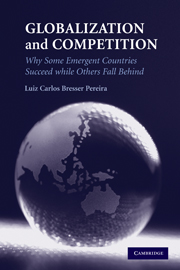7 - Foreign Savings and Financial Crises
Published online by Cambridge University Press: 04 May 2010
Summary
In the previous chapter, we saw how the policy of growing with foreign savings, instead of causing growth by increasing investment, principally increases domestic consumption and causes the substitution of foreign for domestic savings. This substitution happens always – and only in particular situations, when the country is already growing fast and the propensity to consume has fallen – if this rate not high. In this chapter, we see the second perverse effect of the growth with foreign savings policy. As one of the factors that contribute to magnifying the tendency of the exchange rate toward overvaluation, the recourse to foreign capital to finance growth brings about recurrent balance-of-payment crises. As we saw in Chapter 4, the others factors are the capital deepening policy; the use of the exchange rate as a nominal anchor against inflation; exchange rate populism; and the policy of foreign indebtedness to overcome the insufficiency of foreign currencies, or the “two gaps,” that would characterize developing economies. In this last chapter, we examine the financial crises of the 1990s, which began with the 1994 Mexican crisis and ended with the 2001 Argentinean crisis.
We have chosen to examine the period 1994–2001 not only because balance-of-payment crises were frequent in this period but also because in the early 1990s, the U.S. Treasury, the IMF, and the World Bank defined growth with foreign savings as the official Washington Consensus policy to promote economic growth.
- Type
- Chapter
- Information
- Globalization and CompetitionWhy Some Emergent Countries Succeed while Others Fall Behind, pp. 204 - 219Publisher: Cambridge University PressPrint publication year: 2009

